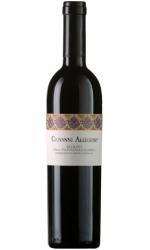Rondinella grapes
Rondinella grape variant is a grape largely grown in the Veneto region of Italy and extensively used in making the famous Italian red wine.
This grape variant forms an integral part of the wines such Valpolicella and Bardolino and it is also often blended with wines like Corvina and Molinara, adding herbal flavours to it.
As far as the parentage of this grape is concerned, it is a mutation of Corvina and the DNA carried out in 2005 on this grape proved it.
Rondinella grape variety is quite generous and rustic, when it comes to the body and grows well in soil having a high clay content, which is typically not much exposed.
This wine is more likely to be the early version of a Recioto or an Amarone, made using the Rondinella grapes and its blending associates Molinara and Corvina.
The process of making Recioto or Amarone, which is called as ‘straw technique’, in which grapes are dried on the straw mats, is passed on to the modern world by the ancient Greeks.
In 643 AD, King Rotari of Rombard made an announcement to protect Rondinella and other varieties of grapes from being destroyed by the farmers in their fields.
Venice became the main trade center during the Byzantine Empire, which was well known for its export of wines, especially the Valpolicella wine (the wine which derives its name from the combination of Latin and Greek words which means wine drawn from cellars) which was made from Rondinella and its other blending partners.
However, soon local trade restrictions were placed by the Ottomans which forced the winemakers of the region to broaden their scope of local viticulture.
Even in the 19th century the Rondinella grape faced the Phylloxera crisis, but was able to avert it, and avert it quickly to a large extent.
The production of the grape continued to grow, though it began being used in the style of Bardolino, which had Rossignola added to the identical grape blends as Valpolicella and Amarone, but not being made from the dried grapes.
The Amarone winemaking process regained a resurgence of sorts in the 1950s and today, Recioto and Amarone are amongst the most sought after wines of the world.
-

Corte Giara – Amarone della Valpolicella 2012 75cl Bottle
€33.02 Find merchant -

Bertani – Amarone Valpolicella Valpantena Doc Villa Arvedi 2010-12 75cl Bottle
€48.20 Find merchant -

Tommasi Viticoltori – Ca Florian Amarone della Valpolicella Classico Doc 2008 6x 75cl Bottles
€291.25 Find merchant -

Tommasi Viticoltori – Ripasso Valpolicella Classico Superiore DOC 2013 75cl Bottle
€16.73 Find merchant -

Tommasi Viticoltori – Arele Rosso 2013 6x 75cl Bottles
€77.22 Find merchant -

Tommasi Viticoltori – Rafael Valpolicella Classico Superiore DOC 2013 6x 75cl Bottles
€68.59 Find merchant -

Tenuta Musella – Amarone 2010 75cl Bottle
€29.84 Find merchant -

Tommasi Viticoltori – Fiorato Recioto della Valpolicella 2012 12x 37.5cl Half Bottles
€194.60 Find merchant -

Allegrini – Giovanni Allegrini Recioto Classico 2010 6x 50cl Bottles
€175.72 Find merchant -

Alpha Zeta – A Amarone 2012 6x 75cl Bottles
€174.38 Find merchant -

Leonildo Pieropan – Amarone Vigna Garzon 2010 6x 75cl Bottles
€252.83 Find merchant -

Terre di Valgrande – Valpolicella Ripasso DOC 2013 6x 75cl Bottles
€73.81 Find merchant
Characteristics of Rondinella Grape
The Rondinella grape derives its name from the same word, which actually means a ‘small swallow’.
The leaves of this grape variety represent the swallow’s tail, justifying the name reference.
The berries of this grape variety appear intense, dark coloured, round in shape and small in size.
As far as the size of the bunch is concerned, they grow to a medium size and appear to be loosely packed with a cylindrical shape.
And this grape is perfectly adapted to drying and shriveling, used for the drying process which goes into the making of Amarone and Recioto wines.
Rondinella grapes easily grow all across the Valpolicella region. This grape is quite noted for the prolific yields it gives.
However, this prolific yield, takes a toll on the quality of the grapes. This grape gives a neutral flavour and hence Rondinella grapes are rarely used to produce a varietal wine.
The Rondinella grape vines are well resistant to grape diseases and rot, thanks to the thick skin of the berries.
These grapes have a high sugar level which greatly helps in the production of straw wines made using the ‘Appassimento method’, where the grapes are required to dry out well.
Flavours and Aromas of Rondinella
The blended Venetian wines give a light fragrance of cherries, flowers and strawberries with a slight finish of bitter almonds.
The Rondinella grapes occupy almost 20-30% space when the variant is blended with other grape varieties to produce Valpolicella and Amarone wines.
The wines made using Rondinella grapes usually have an intense ruby red colour with a very gentle, but a distinct aroma.
These grapes are quite fruity and give an aroma which is not tannic, having a great palate structure.

Michael Bredahl
Wine Writer
Michael is an online enthusiast, with a lot of knowledge about online marketing. Traveling around the world to hunt for the perfect wine. Latest on Sicily, where Etna has a huge impact on the taste, which is strong with a bitter aftertaste for the youngest wines, but older wines are fantastic. Drinking wine, and writing about them, are one the passions. Remember to drink responsibly 🙂
Are you a Copywriter?
We have a lot of articles without much content, if you can do it better, you are welcome to write a nice article, and get the proper credit for that. Read more information about beeing an author, and Contact us for more information.
























